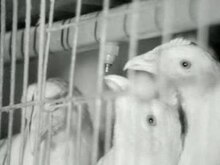Battery cage
From Wikipedia, the free encyclopedia
Battery cages are a housing system used for various animal production methods, but primarily for egg-laying hens. The name arises from the arrangement of rows and columns of identical cages connected together, in a unit, as in an artillery battery. Although the term is usually applied to poultry farming, similar cage systems are used for other animals. Battery cages have generated controversy between advocates for animal welfare and industrial producers.

Battery cages in practice
Battery cages are the predominant form of housing for laying hens worldwide.[1][2][3] They reduce aggression and cannibalism among hens, but are barren, restrict movement, prevent many natural behaviours, and increase rates of osteoporosis.[3] As of 2014, approximately 95% of eggs in the US were produced in battery cages.[4] In the UK, statistics from the Department for the Environment, Food and Rural Affairs (Defra) indicate that 50% of eggs produced in the UK throughout 2010 were from cages (45% from free-range, 5% from barns).[5]
The EU ban on caged hens
The European Union Council Directive 1999/74/EC[6] banned conventional battery cages in the EU from January 2012 for welfare reasons. This has led to a significant decrease in the number of eggs from battery cages in the EU.[7][8] The 2012 battery cage ban was publicised as heralding an end to caged hens throughout Europe, but it created a widely held misconception that all laying hens in the UK are now either free range or barn birds. That is not the case; although battery cages are illegal, farmers have skirted the ban by providing slightly bigger cages with “enrichment” such as perches. The hens in these conditions are now called “ex-cage colony hens”.[9]
HISTORY
An early reference to battery cages appears in Milton Arndt’s 1931 book, Battery Brooding, where he reports that his cage flock was healthier and had higher egg production than his conventional flock.[10] At this early date, battery cages already had the sloped floor that allowed eggs to roll to the front of the cage, where they were easily collected by the farmer and out of the hens’ reach. Arndt also mentions the use of conveyor belts under the cages to remove manure, which provides better air control quality and reduces fly breeding.[10]
Original battery cages extended the technology used in battery brooders, which were cages with a wire mesh floor and integral heating elements for brooding chicks. The wire floor allowed the manure to pass through, removing it from the chicks’ environment and reducing the risk of manure-borne diseases.
Early battery cages were often used for selecting hens based on performance, since it is easy to track how many eggs each hen is laying if only one hen is placed in a cage. Later, this was combined with artificial insemination, giving a technique where each egg’s parentage is known. This method is still used today.

Video advertising the system in the early history of the battery cage
Early reports from Arndt about battery cages were enthusiastic. Arndt reported:
This form of battery is coming into widespread use throughout the country and apparently is solving a number of the troubles encountered with laying hens in the regular laying house on the floor.
In the first edition of this book I spoke of my experimental work with 220 pullets which were retained for one year in individual cages. At the end of this year it was found that the birds confined in the batteries outlaid considerably the same size flock in the regular houses. The birds consume less feed than those on the floor and this coupled with the increased production made them more profitable than the same number of pullets in the laying house.[10]
A number of progressive poultrymen from all over the United States and some in foreign countries cooperated with me in carrying on experimental work with this type of battery and each and every one of them were very well satisfied with the results obtained. In fact, a number of them have since placed their entire laying flocks in individual hen batteries.[10]
In 1967, Samuel Duff filed a patent for “battery cages” in patent US3465722.[11]
The use of laying batteries increased gradually, becoming the dominant method somewhat before the integration of the egg industry in the 1960s. The practice of battery cages was criticized in Ruth Harrison‘s landmark book Animal Machines, published in 1964.[12]A simple battery cage system with no conveyors for feed or eggs
In 1990, North and Bell reported that 75% of all commercial layers in the world and 95% in the United States were kept in cages.[13]
By all accounts, a caged layer facility is more expensive to build than high-density floor confinement, but can be cheaper to operate if designed to minimize labor.
North and Bell report the following economic advantages to laying cages:
- It is easier to care for the pullets; no birds are underfoot.
- Floor eggs are eliminated.
- Eggs are cleaner.
- Culling is expedited.
- In most instances, less feed is required to produce a dozen eggs.
- Broodiness is eliminated.
- More pullets may be housed in a given house floor space.
- Internal parasites are eliminated.
- Labor requirements are generally much reduced.[13]
They also cite disadvantages to cages:
- The handling of manure may be a problem.
- Generally, flies become a greater nuisance.
- The investment per pullet may be higher than in the case of floor operations.
- There is a slightly higher percentage of blood spots in the eggs.
- The bones are more fragile and processors often discount the fowl price.[13]
Disadvantages 1 and 2 can be eliminated by manure conveyors, but some industrial systems do not feature manure conveyors.[14]


Add comment
You must be logged in to post a comment.